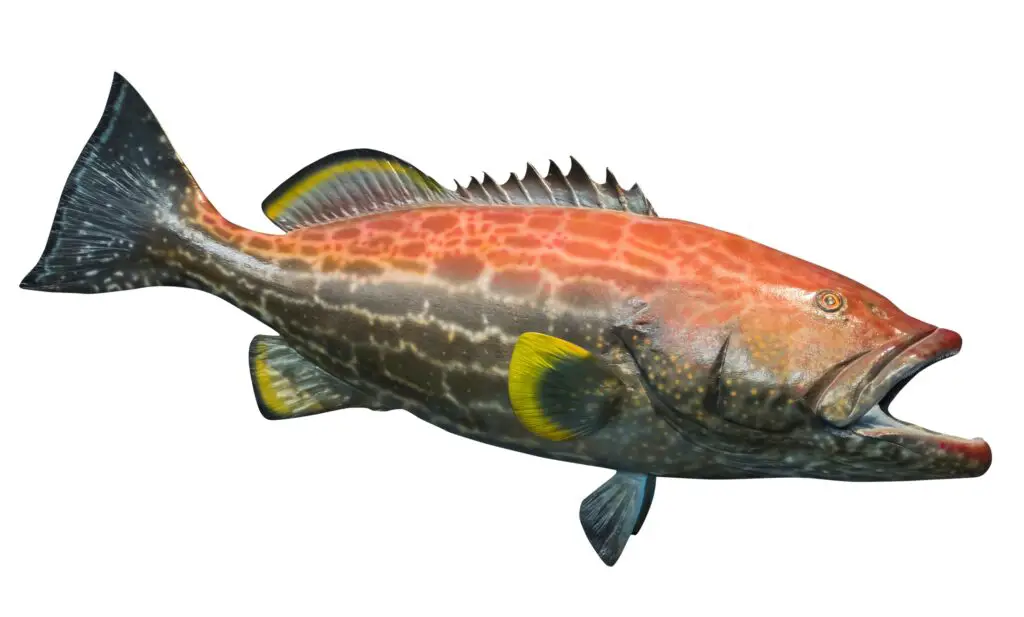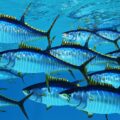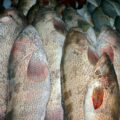The yellowfin grouper is a well-known species of grouper due to its appearance. This ray-finned fish is not found everywhere, but if you know grouper, you must have seen the pictures of this fish at least once.The yellowfin grouper is from the subfamily Epinephelinae and the scientific name for the species is Mycteroperca Venenosa. The fish has the appearance of other groupers, but it is colored differently than most. It is a fish species found in the Atlantic Ocean with some other grouper species like Goliath grouper and misty grouper.
What does Yellowfin Grouper Look Like?
To start off, we should know exactly what exactly this fish looks like to be able to catch it. Many grouper species often get confused with other ones because they can look quite similar. Just like most groupers, the fish has an elongated and robust body, with the lower jaw being more extended than the upper jaw. The head and body of the grouper are marked with dark spots all over. Some larger species of yellowfin grouper also have small bright spots on the lower parts of the body. When it comes to the fins, the dorsal fin contains 11 spines and 15–16 soft rays, while the anal fin contains 3 spines and 10–12 soft rays.
This fish has two color morphologies, depending on what area of the water it occupies. It is grayish green in shallow water, while species that are found in deeper water are bright red, as these colors help them morph better into their surroundings. The name “yellowfin” was given to this fish because the outer thirds of the pectoral fins of this fish are always bright yellow in color. This helps identify them, as these fish can get confused for black grouper since they occupy the same habitat. The juvenile and adult fish look similar, but the caudal fin of a juvenile fish is straight, while it is more concave in the adult fish.

What is the Lifespan of Yellowfin Grouper?
Groupers usually have a pretty long lifespan. These fish can keep growing until they are caught or eaten by another, bigger fish. Considering this, the average lifespan of a yellowfin grouper is between 10 and 15 years. However, sometimes similar grouper species can live for around 20 years, as well. The maximum observed age for the yellowfin grouper is 15 years. When grouper species are larger, they have longer lifespans, with some living as much as 50 years. Most fish cannot reach their maximum lifespan because living and surviving in the ocean is not the easiest.
What is the size of the yellowfin grouper?
The size of the yellowfin grouper is large, but it is not as large as some other species of grouper, most famously the goliath grouper. The size of the grouper gets big due to its heavy weight, which also contributes to the fish looking bigger.
The yellowfin grouper can get as large as 39 inches in size, but most of these fish do not reach this size. Most yellowfin groupers remain around 18 inches, which is pretty small compared to other groupers. The weight of the yellowfin grouper is usually around 41 lbs., but of course, it depends heavily on the length or size. The bigger the yellowfin grouper, the more it weighs. The maximum size of this grouper was 39.4 inches, and it weighed 40.8 lbs. Just because a bigger yellowfin grouper has not been caught does not mean that it does not exist.
Remember, there is a yellowfin grouper with a bright red color that lives in much deeper water and is much harder to catch and locate. This means that there is a big chance that this fish will live for much longer and can get much bigger as well.
What is the Habitat of Yellowfin Grouper?
The habitat of yellowfin groupers is wide. Groupers are a species of fish that can be found all over the world; in every type of water that there is. A lot of these species are located in oceans, and this is one of them. The yellowfin grouper is found in the western Atlantic Ocean. This includes Florida, the Gulf of Mexico, Texas, the Bahamas, and Bermuda. The fish have also been located on the Caribbean coast of South America and near the Brazilian coast. This species of grouper is only found in the coastal and offshore oceans, where it finds its prey.
When it comes to where in the ocean this fish is found, it can be located anywhere from the depths of 7 feet to 450 feet. The one closer to the top of the water is grayish, and as the species moves toward the bottom, it gets redder. The juvenile fish is found in seagrass beds or turtle grass, where it stays hidden from predators until it is big enough to move offshore safely. The adult fish is usually found near reefs and rocky or muddy bottoms, like most other groupers. When the water gets cooler, the fish do move closer to the shallower water to take up some of the sunlight, especially during the daytime.
What is the Diet of Yellowfin Grouper?
Just like every other creature in the ocean, the yellowfin grouper needs to eat. In fact, the main purpose of the life of fish is to prey and reproduce. The yellowfin grouper is piscivorous, which is a division of carnivorous. This title means that this fish is carnivorous and feeds mainly on fish only instead of other small ocean animals.
Most fish that live near reefs and corals feed on fish that come near this habitat. These fish are usually small and hide near the reefs from predators. Some of these fish also form shoals and schools to survive the predators. The coral reef fishes are very colorful as well and include a yellow tang, triggerfish, damsel fish, toadfish, and much more. These places also have sea horses, squids, and other small crustaceans. The diet of yellowfin grouper consists mostly of these small fish and squid.
Some fish are known to be brave, targeting fish of similar size to them or even bigger than them. The yellowfin grouper is the opposite; it only targets fish that are very small and easy to eat. The yellowfin grouper likes lurking among the reefs, wrecks, or ledges to locate nearby prey. Once it sees one, the fish sucks the fish in its mouth using its powerful mouth suction ability and swallows the prey whole. There are teeth lining the jaws, tongue, and palate of the fish, which aid in the digestion of the prey.
How does Yellowfin Grouper Reproduce?
Now, the reproductive method of yellowfin has not been studied that extensively, but it is believed that the fish behaves like other grouper fish. This means that the fish is a protogynous hermaphrodite, like its cousin species. So, what is a protogynous hermaphrodite? It is when all the fish that are born are female, but after reaching sexual maturity, they can turn into male fish and finally take part in sexual reproduction. This is a way to reproduce most effectively, as these fish do not reproduce often.
When the female fish reaches around 20 inches or 4.6 years of age, it can change its sex. It only happens if the female is large and strong enough to fertilize all the eggs. Some batches may not have many males, or some might have very few. Due to this behavior, more of the yellowfin groupers are naturally female. Once the sex change is done, the male fish then forms a harem and fertilizes many of the female fish at once. However, it should be noted that this behavior has not been definitively shown.
It is also believed that they have a long reproduction period, which lasts from January to August. This is to compensate for the weird reproduction behavior that they have. When the fish are reproducing, they have a white patch on their heads. The fish form spawning aggregations and the site where they spawn is shared with other species of grouper like Nassau, tiger, and black grouper. This means that the fish are pretty peaceful with other grouper species living in the same area.
What is the Taste of Yellowfin Grouper?
The yellowfin grouper is caught for recreational purposes, but it can also be caught for commercial purposes. The fish is not very popular to eat as it is believed to have ciguatera poisoning. Eating this fish can cause diarrhea, vomiting, dizziness, and weakness, among other symptoms. However, there are some areas where the fish is believed to be safe to eat.
The taste of the grouper is mild, somewhere between halibut and seabass. It has a mild and sweet taste that tastes great with other marinades and flavorings because it can absorb them well and not mess with them with its own taste. The fish also has huge flakes, which remind me almost of lobster and crabs. When cooked, the fish retains a lot of moisture and cannot be overcooked. Since it is a firm fish, unlike the other ones, this one can be grilled, fried, sauteed, broiled, steamed, or baked. It is also excellent in soups and chowders. The fish can be grilled on a grill and will not fall apart but instead will get a nice char. Therefore, if possible, the yellowfin grouper should be tasted at least once in this lifetime.
How to Catch Yellowfin Grouper in Florida?
The grouper can be caught in Florida, but according to the Gulf of Mexico Fishery Management Council, there are limits to how many fish can be caught. Yellowfin groupers with a size above 20 inches cannot be caught, and there is also a limit of 4 groupers per person. There are also harvest limits for this fish per person that can be found on their website.
To catch the fish, you need a strong hook and line. Another very important part is the bait. The bait should be fresh and stinky, because the more it smells, the more the fish will be attracted to it. Some baits that can be used are pinfish, goggle eyes, and pilchards. Once selected, make sure to hook the bait properly. Most of these fish are found in deep water near reefs, rocks, wreckage, and other such hard-to-reach places, so it is easy to lose your bait on the way.
Also, trolling is the best way to catch grouper. Most times, it is recommended to use live bait as it acts like a live fish but not in this case. The yellowfin groupers are very careful and only attack when the fish is not moving as much, which is why you need a dead fish. By trolling, you can slowly move the fish so it still looks somewhat alive and can lure the fish out of its hiding place. The rest depends on how well you are experienced.
When to Catch the Yellowfin Grouper?
The yellowfin grouper can be caught year-round because it is not yet a threatened species. However, according to the Gulf of Mexico Fishery Management Council, the fish cannot be caught during February and April. The fish are also active from January until August because that is their reproduction period. When it comes to the season, the fish are mostly caught in the summer because it is easier to catch them then, but they can be found in shallow water in the winter as well, especially during the day. Also, most people prefer fishing during the day when the visibility is good, but at night it can be more peaceful. It really depends on what suits you the best.
Conclusion
The yellowfin grouper is another grouper species found in the Atlantic Ocean. It is an interesting species with a unique appearance, habitat, size, taste, and much more. Now you also know how to catch fish in Florida and when the right time is.











